21 Things to Do Instead of Self-Harming
Editor's Note
If you struggle with self-harm or experience suicidal thoughts, the following post could be potentially triggering. You can contact the Crisis Text Line by texting “START” to 741741. For a list of ways to cope with self-harm urges, visit this resource.
There are many reasons you may have the urge to self-harm, whether you’re feeling big emotions like anger or sadness, want to feel less numb and dissociated or want to make your pain visible. Regardless of why you might self-harm, know your feelings are valid.
“[Self-injury] does serve a purpose, it is being done for a reason,” Stephen P. Lewis, Ph.D., co-founder of Self-injury Outreach and Support and associate professor of clinical psychology at the University of Guelph, told The Mighty. “For many people, it’s because they’re experiencing intense and painful emotions, and they may not know another way to express that to get relief from it to cope with it.”
One of the best ways to learn new ways to handle these painful feelings and experiences are coping skills, which can divert your attention away from what’s going on long enough to resist the urge to self-harm. Getting used to using coping skills when you’re struggling will take time and practice.
Here’s the thing about coping skills. They don’t work the same as self-injury. In fact, at first it may feel like they don’t work at all. The purpose of coping skills isn’t to take away all the intense emotions you might be feeling, but to make them tolerable enough you can cope until the big feelings pass. You may hear this called “riding the wave” or “urge surfing” — you let the emotions and self-harm urges pass through.
Self-harm can make you feel better right away, but in the long run you are at risk of serious injury. Plus, the relief you feel from self-injury is only temporary. When you learn new tools like coping skills, difficult emotions and experiences won’t feel so overwhelming — even if that’s hard to believe right now. That’s why it’s important to find alternative ways to cope and distract yourself from the emotions and reasons you self-harm.
It may take you some time to find coping skills that work for you, and they may be different depending on how you’re feeling. If you’re angry, you might need to do something more physical like go for a run. When you’re sad, it might be more helpful to listen to music and pet your dog.
Try more than one coping skill and experiment. Work with someone you trust or your therapist if you need some guidance or additional suggestions. Know that with practice, you can learn how to use coping skills to manage when things get really hard.
We surveyed 2,500 people in The Mighty community with a history of self-harm about their go-to coping skills. Out of more than 40 coping skills, those who took the survey told us which ones they actually use when they have the urge to self-harm. The most common answers, listening to music and crying, were used to cope with self-injury by 45% of people who took the survey. We collected all the skills at least 15% of survey participants said they used.
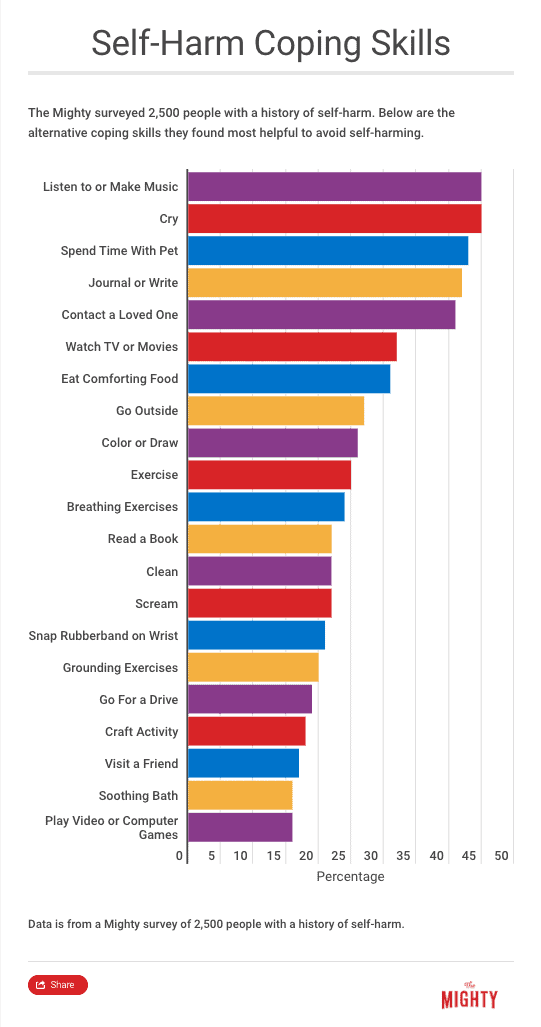
Sometimes a long list of ideas for how to cope with self-harm urges can be overwhelming. We’ve created a visual reminder (and you can download your own copy) along with descriptions below.
Here are the top 21 coping skills people who responded to our Mighty survey said they use most often that you can also try right now:
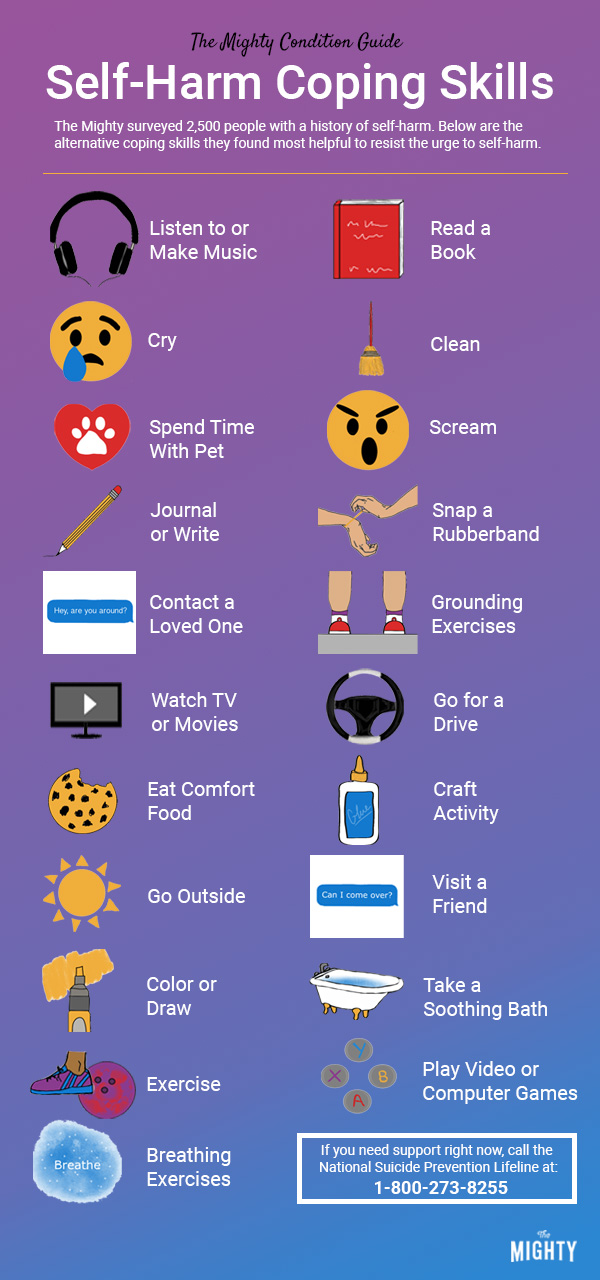
For a downloadable PDF version of this list of coping skills, click here.
1. Listen to or Make Music

No matter what kind of day you’re having, there’s usually a song to match. Therefore, it’s no surprise that listening to (or making your own) music was tied as the top answer when we asked The Mighty community about self-harm coping skills. Music can provide a great distraction, provide an outlet for what you’re feeling and take your mind off self-harm until the urge passes.
Need some song recommendations? Here’s what helped others in The Mighty community:
- 25 Songs That Have Helped People Living With a Mental Illness
- 30 Songs That Have Helped People With Anxiety and Depression at Night
- 21 Songs People With Anxiety and Depression Recommend
2. Cry

Crying is one of the natural ways you have to express how you’re feeling, whether it’s sadness, pain, heartbreak or even anger and frustration. Crying was tied as the number one go-to coping skill The Mighty community reported using. It can help reduce your stress level, release some of those pent-up feelings and can even be a way to self-soothe when you have the urge to self-injure.
3. Spend Time With a Pet

There are many reasons spending time with your pet can help you cope with self-harm urges, whether you’re tossing the ball for your dog or curled up on the couch with your cat. Mighty community member Hazel K. explained why her cat, Nugget, is so helpful to her mental health. She said:
Nugget is able to sense when I’m in pain or distress and will be by my side to keep me calm. She’s such a silly animal in the best kind of way and so caring and affectionate — she’s helped me through some of my most difficult times and genuinely is often my reason to get out of bed in the morning.
4. Journal or Write

If you self-harm because it’s difficult to express your feelings, especially when they’re big or intense, journaling or any kind of writing about what you’re going through can be a helpful release. You can also scribble and doodle whatever you’re feeling into your journal instead of on your body through self-harm. If you want to share your writing with others who care, you can post on The Mighty using #MightyPoets or #SelfHarm.
5. Contact a Loved One

You’re not alone, so if you have the urge to self-harm, reach out to someone you love. If you trust them when you’re dealing with self-injury thoughts, you can share what you’re feeling or ask for a distraction. But you don’t have to mention or talk about self-harm at all — you can always catch up about your day, gossip about the latest celebrity drama or just send a text message hello to remind yourself there are others out there who care about you.
6. Watch TV or Movies

It’s often easy to get lost in a story, especially when there’s a visual element. That’s why watching a TV show or movie can be so helpful for coping when you have the urge to self-harm. You can get caught up in another world for awhile, have a great laugh or learn something new, depending on what you watch. The other good thing about TV and movies is they keep you busy for a set amount of time — and hopefully by then the urge to self-harm will have already passed.
Think you’ve already seen everything in your Netflix queue? Here’s what The Mighty’s community recommends:
- 30 Movies That Have Helped People Through Depression
- 22 ‘Go-To’ TV Shows to Watch When You’re Depressed
- 17 TV Shows (Streaming Right Now) People With Mental Illness Relate To
7. Eat Comfort Food

In our Mighty survey of 2,500 people with a history of self-harm, 31% reported they use comfort food as a way to cope with self-harm urges. Good food not only tastes good, but it can actually trigger the reward system in your brain, which might temporarily make you feel better. In addition, food may have positive memories attached to it, like a favorite grandparent cooking your favorite meal, that might help boost your mood.
If you struggle with disordered eating, this may not be a good option to cope with self-harm for you. If you or someone you know is struggling with an eating disorder, you can call the National Eating Disorders Association Helpline at 1-800-931-2237.
8. Go Outside

Going outside and getting some fresh air may really be just what you need when the urge to self-harm is coming on strong. You could go for a walk, take a stroll around the yard and pick out 10 items you see or just sit on a bench at the park and watch what’s going on around you. This can shift your mood, sure, but it can also take you away from your regular self-harm tools and routine, which might break your self-harm cycle.
9. Color or Draw
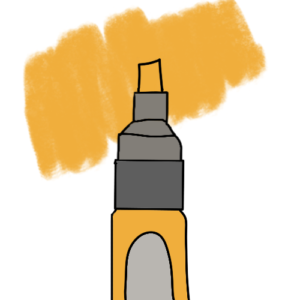
Coloring, drawing or painting is another great way to express what you’re feeling instead of self-harm. Not only can it be distracting, but you don’t have to try and find the “right” words to say what you mean — you can use shapes and colors. You may also find it helpful to draw exactly how you would want to self-harm on paper instead to help the urge pass, though know this can be triggering for some people. Make sure you stock up on art supplies ahead of time and have coloring books, paper, pencils, crayons or markers easily accessible.
10. Exercise

Sometimes you may feel the need to self-harm when you get worked up and angry, maybe feeling like you have too much pent-up energy. At these times (and others!), exercise might be a great option to cope with self-harm urges. You can go out for a walk or a run or even try other physical activities like bowling or dodgeball. Moving your body can help get out some of that aggressive energy without needing to self-harm.
11. Breathing Exercises

When you’re feeling the urge to self-harm, sometimes breathing exercises can help calm down your nervous system enough that the urge passes. Breathing also helps bring you back into your body and the present moment. This might be helpful if one of the reasons you self-harm is because you feel numb or dissociated or are experiencing past traumatic memories.
If you need a breathing exercise to try, Mighty contributor Osmara Aryal suggested a simple exercise — coherent breathing — to get you started. Here’s how it works:
Coherent breathing is simple enough that you can practice it anywhere such as waiting in line at the store or at your work desk in the office because no one can tell you’re practicing it.
How to:
1. Breathe normally and through your nose.
2. Relax your shoulders, neck, face, jaw and mouth.
3. Inhale for six counts.
4. Exhale for six counts.
5. Repeat steps 3 to 4 for a minimum of five minutes.
12. Read a Book

Just like watching TV or a movie, reading a good book can be a great way to distract yourself because you can get lost in another world for awhile. Whether you’re reading a mystery novel, romance novel, the latest true crime nonfiction or “Harry Potter” for the ninth time, reading a book can get your mind off what’s bothering you for a few moments, at least long enough to avoid self-harm. You can also try listening to an audiobook as an alternative coping option.
Need suggestions for your self-harm coping reading list? Here are some books that helped others in The Mighty community:
- 20 Books That Have Helped People Through Depression
- 15 Books That Have Helped People Through Anxiety
- 3 Picture Books to Read in Times of Emotional Distress
13. Clean

Cleaning may not be the first self-harm coping idea that comes to mind, but for 22% of those who took The Mighty’s survey, it works. Typically cleaning tasks, like doing the dishes, sweeping or organizing, are pretty simple, so they don’t require much heavy duty thinking. At the same time, cleaning focuses your attention on a goal that’s not self-harm. Cleaning is also physical so if you’re feeling things in your body that might lead to self-harm, cleaning can help get that energy out in a more productive way.
14. Scream

Let’s be real, sometimes the world is frustrating and it might make you mad, sad and everything in between. If those are some of the big emotions behind your self-harm urges, try screaming it out. You’ll express the feelings in a safer way and use up some energy that might otherwise go into self-injury. It might be hard to use this coping skill if you live with others, so if you can’t find a place to scream, try screaming into your pillow — it will muffle the sound.
15. Snap a Rubberband on Your Wrist
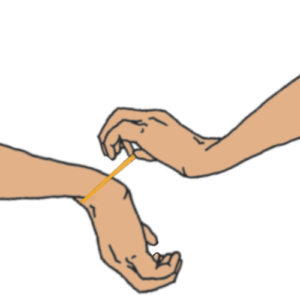
For some people — and 21% of The Mighty’s self-harm recovery community — snapping a rubberband against your wrist can provide some relief when you’re dealing with self-harm urges. The snap of the rubberband gives you a little bit of the physical sensation in a much safer way than self-harm, which might be enough to get you through. However, know for some people, techniques like snapping a rubberband (or holding ice) may trigger self-harm urges, so see what works best for you.
16. Try Grounding Exercises

Grounding exercises are designed to bring you back into the present moment and into your body. Sometimes with self-harm, especially if you’re feeling empty or disconnected, it’s about trying to feel something, anything. Grounding may be an alternative that works for you. Some common grounding exercises that help people include looking around the room and finding every object that’s green, concentrating on feeling your feet flat on the floor or using essential oils.
Need other ideas for grounding exercises? Here are some ideas recommended by The Mighty’s community:
- 15 Grounding Exercises to Manage Stress From Anxiety or Trauma
- 11 Unexpected Ways People ‘Bring Themselves Back’ From Dissociation
- 16 Grounding Techniques That Help With My PTSD and Anxiety
17. Go for a Drive

If you’re safe enough to drive, it’s one coping skill that might be helpful if self-harm helps you feel a sense of control — driving can be empowering. Driving also temporarily takes you away from your self-harm tools (and maybe even some of your triggers) and gives you a change of scenery. In addition, driving requires attention to the road, traffic signals and things going on around you, so it can be both a distraction and a way to get yourself back in the present moment.
18. Do a Craft Activity
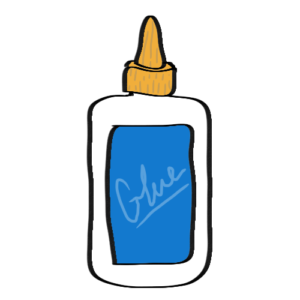
When the urge to self-harm arises, try a craft or creative activity instead. It’ll cause a diversion because you have to concentrate on the craft and it can help you express some of what you’re feeling. Some people also like to create things for others, which may give you an extra incentive to get out the glue. The sky’s the limit, but Mighty contributor Elizabeth Pidgeon recommends trying modeling clay, stenciling, origami, crochet or knitting or friendship bracelets to start. She added:
By practicing these crafts, I’m able to express my emotions while also doing something in the present moment. It allows me to feel grounded in my life, but I also simultaneously know that I’m creating something beautiful that I can share with whomever I choose.
19. Visit a Friend

For a good distraction when you feel like self-harming, contact a friend and ask if you can visit. This gets you out of the house, gives you something different to think about and provides support, whether you talk about self-harm or not. Humans are made for connection, so when you’re really struggling, spending time with loved ones may be just the thing to get you through these self-harm urges.
20. Take a Soothing Bath

If there was ever a coping skill cliche, taking a soothing bath would be it. However, there’s a reason it makes almost every self-care list — sometimes, it helps. Self-harm is something you do to your body, so turning to another, safer body-related activity like a bath may be a helpful alternative. You can use warm or cool water and add bubbles or essential oils to engage your other senses. Especially one reason you self-harm is to take care of or nurture yourself, a soothing bath may be an important replacement to try when you have the urge to self-harm.
21. Play Video or Computer Games

Video or computer games (or games you play on your phone) can suck your attention in really fast, which is perfect when thoughts of self-harm start to creep in. Some games, like “Candy Crush,” take focus but not a lot of strategy. On the other hand, more involved games, like “World of Warcraft” take strategic planning, collaborating with others and delving into another world. Either type of escapism may be helpful when you need to take your mind off things.
Want to learn more about healing from self-harm? Check out The Mighty’s Guide to Understanding Self-Harm:
- What Is Self-Harm?
- Understanding Self-Harm for Young People
- Understanding Self-Harm for Adults
- What to Do If Your Child or Loved One Is Self-Harming
- Self-Harm Resources
Article updated Aug. 26, 2019

